From Tannat to Souzão: Sunday Morning Tasting at Bending Branch Vineyards
As I drove from my personal piece of the Texas hill country to Bending Branch Vineyards just a short stretch of road from old town Comfort, Texas, I saw the toll taken by the summer heat and drought of 2011. There were empty stock tanks holding wisps of wind-blown dust and scorched fields of undelivered crops, waving dry and brittle in the arid wind. But, as I approached Bending Branch I saw hope for better times in Texas in the reduced but still flowing waters of the Guadalupe River.
As entered the tasting room at Bending Branch Vineyards and took solace from the heat within its limestone walls, I was greeted by Robert Young, its owner and winemaker. I asked him what the year had been like for his young estate vineyard. Bob said, “Obviously, it’s been a hot dry year, but we are still planting more vines. We took a first small harvest from our second year vineyard. Our wells appear OK and as long as they keep flowing, we will be able to handling it. These are definitely challenging times and I’m hoping that things will change soon.”
I reflected for a moment on Bob’s hopeful words and thought, how can his tender young vines possibly survive. But, I reckoned that if they do, they’ll probably have the tenacity to survive anything Mother Nature can throw at them in Texas: a necessary trait for grape varieties that will success here.
Bob Young’s passion has purpose. Most of the wines he is interested in making come from grapes that are not the standard varieties of Cabernet, Merlot and Chardonnay that you know from your favorite wine shop. He knows that Texas ain’t Bordeaux and sure as hell ain’t Burgundy. His grapes come with a heritage of hot climes and sandy limestone soils that they now experience in Texas. They are grapes from the Iberian regions of Spain and Portugal, Sardinia and Italy, and the southern borders of France: Rhone Valley and the Pyrenees mountains: Vermentino, Roussanne, Tannat, Tempranillo, Mourvedre and Souzão.
To prime his efforts, Bob started (after a career as an MD) with a viticulture and winemaking course at the Atlanta Wine School, followed by a winemaker’s certificate from UC Davis in California. Bob’s viticultural support comes from his son-in-law, John Rivenburgh, a San Antonio native and Vice President of Operations. He recently completed the Texas Tech’s professional viticulture management program.
Bob, John and their family operation are preparing to make wine from the aforementioned grapes from their estate vineyard. However, in the meantime, they are gaining valuable experience making wines from similar grapes found on the Texas High Plains in the vineyards of Vijay Reddy and Neal Newsom, and grapes grown in a non-Texas but similar growing conditions in Lodi and the Sierra Foot Hills in California.
Sitting and talking in the Bending Branch tasting room, Bob poured me a new Rosé that he made from an unconventional blend. It was based on Tannat blended with 25% Cabernet Sauvignon and15% Mourvedre. Each wine was made separately from the free-run juice then blended together. In its labeless bottle, it gave a red-purple color, but in the glass it gave way to a pink-salmon color of the classic Rosés of southern Europe. On the palate, it had a light tannic structure, a silky richness and moderate acidity. It wasn’t a Rosé that I’d call high and bright. It was more old-world in character with mineral and black cherry.
Bob said, “No acid was added after the grapes came to the winery. This wine was totally out of the grapes, a weighty wine that will go well with a varietal of meat dishes. As soon as we get our labels from the printer, we can start to sell it, hopefully soon.”
While I savored the wine, Bob gave me a bit of his personal wine philosophy that he hopes that wine drinkers around Texas will share. If I understood him correctly, his sentiments for Texas were that we need to drink what excels locally, focusing on those varieties of grapes that like the heat, can be sustainably and economically grown, and made into the best wine that can be made here. Additionally, he is focusing on wines of depth and character, for his red wines, this is the Texas equivalent to the Red Zinfandel’s of California. To put it simply in his words…”These are big red wines.”
To illustrate what he means, Bob poured me three of Bending Branch’s big reds. The first two were made from Tannat, a red grape historically grown in southwestern France in the Madiran AOC and is now one of the most prominent grapes in Uruguay, where it is considered its “national grape”. Yet, Tannat is relatively unknown in the USA.
Bob’s first Tannat was made from grapes grown in Paso Robles on 5 year vines. It showed a purple-red color with fruit aromas (red/black cherry/plum) and an aromatic hint of mint. Bob said, “I’ve been experimenting with different winemaking styles: hyper cold soaking at 39 F, regular fermentation, and extended macerations of up to 30 days. The wine in my glass was a blend of the cold soak and the regular fermentation, which came out with similar characteristics.
The second Tannat he poured for me was made from the same grapes, but the grapes experienced an extended maceration. The resultant wine was noticeably darker and thicker than the first and showed a purple-black color and was nearly opaque. The aroma was also different with perceptible smoky and chocolate characteristics along with a persistent mineral note through to the finish. While made from the same grapes as the previous wine, this wine definitely had more nuances with characteristics gained from the long period of maceration with extended skin and seed contact. As I finished my taste, Bob placed in front of me a Cowboy boot with a large brass emblem indicating the wine’s Grand Star award from the 2011 Lone Star International Wine Competition. Evidently, the judges agreed with this wine’s outstanding characteristics.
With the lessons gained from recent vintages of Tannat from California and the Texas high plains and the winemaking experiments mentioned above, Bending Branch Vineyards is just on the cusp of what to do with their own grapes. They just brought in their first harvest from their estate vineyard that consisted of 2 tons of Tannat planted in 2009. In addition, the harvest included a small amount of Picpoul Blanc and Petite Sirah.
Bob said, “My plans are to make an Estate Tannat wine from our organically focused vineyard. I will do the Reddy Vineyard Tannat separately. As our signature reds, we are taking different approaches to winemaking with Tannat to demonstrate the multiple expressions of this wonderful variety. For example, (as mentioned below) the extended maceration, the rosé, and later this year a port style wine. We will also have a small amount of the Picpoul Blanc estate wine. I’m still working on a plan for the small amount of Petite Sirah that we harvested this year.”
The third wine was opened with a pop of the cork and the click of glasses. Bob mentioned that it was made from another grape for which he has grand plans in this estate vineyard. It was made from the Portuguese red grape variety: Souzão. He gave me a quick primer on this black-skinned grape that bleeds red juice (something that’s unusual for most red wine grapes). This quality gives it the distinction of being called a “tenturier grape”. The grapes for this wine were harvested in Lodi, California, but Bending Branch just planted it this year in the estate vineyard in Comfort.
The Souzão wine showed its Iberian character, similar to Touriga Nacional that is also being grown in the Texas Hill Country. It had a robust blueberry characteristic aromatics of mint with a thick, rich mouthfeel. One-third of the wine was aged in new American oak barrels and two-thirds in neutral oak for a period 18 months. The rich fruit-forward wine carried the oak well.
Bob said, “This wine fits the profile of the wines that we want to produce at Bending Branch Vineyards. Also, Souzão grows very well in Lodi, so I think we’ll have good luck with it here in the Texas hill country”.
As we were finishing our tasting, John pulled up to the tasting room with their truck pulling a flatbed on which blue plastic bins and a destemmer-crusher were tied down. Bob and John were ready for the seven hour drive up to the Texas high plains where they will work the night to harvest, destem and crush Texas high plains grapes from the 2011 season.
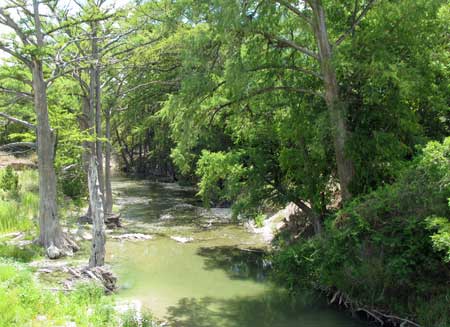
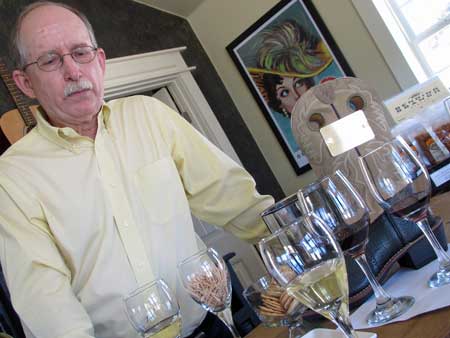
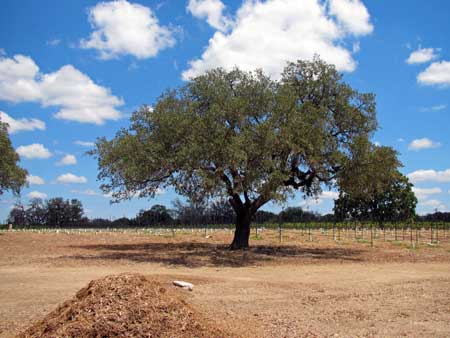
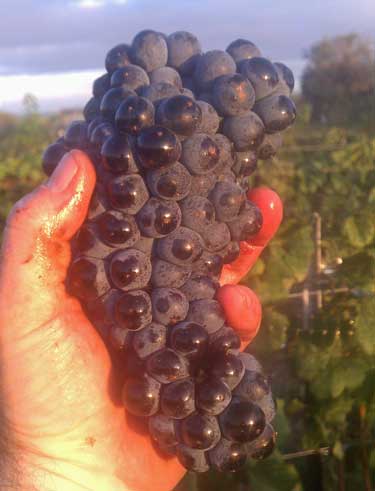
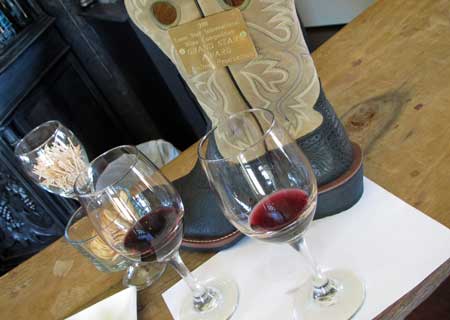
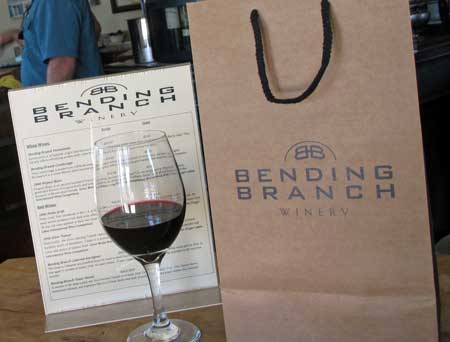

Be the first to comment